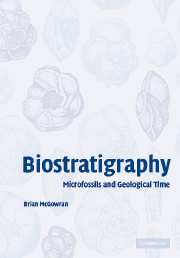Book contents
- Frontmatter
- Contents
- Preface
- Acknowledgments
- 1 Biogeohistory and the development of classical biostratigraphy
- 2 The biostratigraphy of fossil microplankton
- 3 Biostratigraphy: its integration into modern geochronology
- 4 Biostratigraphy and biohistorical theory I: evolution and correlation
- 5 Systemic stratigraphy: beyond classical biostratigraphy
- 6 Biostratigraphy and biohistorical theory II: carving Nature at the joints
- 7 Biostratigraphy and chronostratigraphic classification
- 8 On biostratigraphy and biogeohistory
- References
- Index
2 - The biostratigraphy of fossil microplankton
Published online by Cambridge University Press: 02 December 2009
- Frontmatter
- Contents
- Preface
- Acknowledgments
- 1 Biogeohistory and the development of classical biostratigraphy
- 2 The biostratigraphy of fossil microplankton
- 3 Biostratigraphy: its integration into modern geochronology
- 4 Biostratigraphy and biohistorical theory I: evolution and correlation
- 5 Systemic stratigraphy: beyond classical biostratigraphy
- 6 Biostratigraphy and biohistorical theory II: carving Nature at the joints
- 7 Biostratigraphy and chronostratigraphic classification
- 8 On biostratigraphy and biogeohistory
- References
- Index
Summary
Summary
Although micropalaeontology is almost as old as biostratigraphy itself, it actually flourished as a tool in petroleum exploration from the 1920s (benthic foraminifera), and 1930s–1950s (planktonic foraminifera). Other microfossil groups flourished during the postwar resurgence in marine geology which brought forth the DSDP and ODP. During this progression there was a shift in biostratigraphic emphasis from assemblage zones, where the emphasis was on the fossil contents of the designated stratal section, to species range zones defined on boundary events, i.e., first and last appearances, which led in turn to the ultimate ‘events’, namely speciations and extinctions which could be used in defining rock-free phylozones. We come thereby to (bio)chronozones and datums, which contribute an irreversible succession of events (because evolutionary events are unique) to geochronology.
Introduction
Planktonic micropalaeontology as an active biostratigraphic discipline spans only seven decades. It played no part in the building and embellishment of the geological timescale during the nineteenth century. Adolph Brongniart used the benthic Nummulites in his stratigraphic studies as long ago as the early 1820s and the foundations of micropalaeontology were laid by the great visionary Alcide d'Orbigny – who, however, in this instance concentrated not so much on succession and correlation but rather on the description, general classification and distribution of foraminifera (Glaessner, 1945). Several decades more elapsed before foraminifera were employed in the analysis of strata in the search for water and petroleum.
Information
- Type
- Chapter
- Information
- BiostratigraphyMicrofossils and Geological Time, pp. 19 - 46Publisher: Cambridge University PressPrint publication year: 2005
